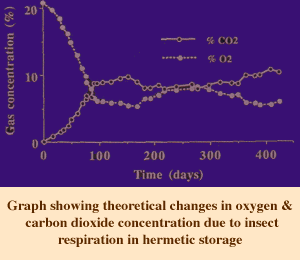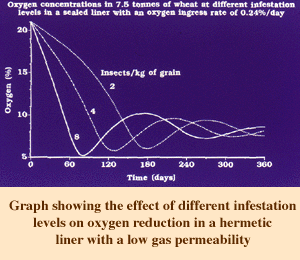

HERMETIC STORAGE OF DRY GRAINS AND OTHER DURABLE AGRICULTURAL PRODUCTS
FACTORS AFFECTING INSECT MORTALITY IN HERMETIC STORAGE
If we can seal the storage ecosystem to prevent air from entering or leaving it, the respiratory metabolism of insects, molds and the grain itself will lower the oxygen content and raise the carbon dioxide content of the intergranular atmosphere to a level where aerobic respiration is no longer possible. This is the principle behind hermetic storage. However, although it sounds simple in theory, in practice it is much more complex. The following brief historical overview will explain much, and link you to our own developments in this field, including summaries of our research studies.
 |
 |
The important role of low O2 concentration rather than high CO2 in causing mortality of stored-product insects in hermetic storage was demonstrated by Bailey (1965). Only later was the importance of the synergistic effect of concomitant O2 depletion and CO2 accumulation for insect control clearly demonstrated (Calderon and Navarro, 1979; 1980). These synergistic and combined effects are essential for successful insect control, as shown by studies of the effects of incomplete air-tightness upon insect populations (Oxley and Wickenden, 1963; Burrell, 1968). Furthermore the lower the grain moisture content (m.c.) and corresponding inter-granular humidity, the higher the mortality, due to the desiccation effect on insects caused by low O2 (Navarro, 1978), or elevated CO2 concentrations (Navarro and Calderon, 1973). The influence of temperature on insect respiration implies that in warm climates O2 intake by insects is very intensive. Conversely in temperate climates, insect metabolism is much slower, depletion of O2 may be lower than its ingress, and insect control may not be achieved. This led Burrell (1980) to postulate that for light infestations of cool grain, residual populations would provide an inoculum for reinfestation after the grain is removed from hermetic storage.
HISTORICAL
Underground pits

The considerable literature on sealed storage of grain termed "air-tight storage" or "hermetic storage" is well summarised by Hyde et al. (1973), and De Lima (1990). From this a clear picture emerges of underground storage in pits, from pre-historic times until the present day as a traditional method that is frequently sufficiently air-tight to enable insects and other aerobic organisms in the grain-mass to reduce oxygen (O2) concentrations below those permitting insect development. These pits were excavated into the soil or rock, and are sometimes lined with supporting walls of brick or cement. However, the ideal situation of O2 depletion and carbon dioxide (CO2) accumulation as demonstrated in laboratory experiments of Oxley and Wickenden (1963) is rarely achieved. This is generally because of gas-exchange through the pit walls and roof, and the sorption of CO2 by the grain itself and sometimes by the pit walls (Hyde and Daubney, 1960).
Semi-underground structures
Large-scale construction for prolonged storage of grain surpluses in Argentina during the second world war consisted of below- and above-ground concrete lined trenches covered with flexible roofs (Anon., 1949). Later attempts at achieving hermetic storage were the Cyprus bins constructed in the 1950s (Hyde et al., 1973). These consisted of concrete lined conical pits surmounted by domed concrete-shell roofs. They were successfully used under hermetic conditions for a number of years. Improved versions of these structures were later constructed in Kenya for hermetic storage of the national grain reserve (De Lima, 1990).
Above-ground small-scale structures

Another traditional method used by subsistence and small-scale farmers has been the storing of grain in sealed gourds, though these provide an incomplete hermetic seal unless treated with a sealing material (McFarlane, 1970). A related method adopted in a number of tropical countries has been the adaptation of empty oil-drums and other metal drums for storage (Pattinson, 1970; Sakho, 1971). To prevent development of heavy infestations before control is achieved, these metal drums should be completely filled. This is because when only partially filled, the headspace volume may remain large (in relation to the grain mass) and developing populations may cause perceptible damage before O2 concentrations are sufficiently reduced to arrest development.
MODERN-DAY HERMETIC STORAGE
Above-ground rigid structures
Documented data on successful application of hermetic storage to above-ground constructions are largely lacking. Many existing silos and warehouses have been modified to provide a high degree of hermetic seal especially in Australia (Delmenico 1993). However, the objectives have been to convert these storages for modified atmosphere (MA) treatments or improved fumigations, and not for hermetic storage as such.
In contrast, the sealing of both bagged stacks and bulk grain in warehouses in China using plastic liners is part of a grain preservation regime termed "Triple-Low". This is an integrated approach to insect control consisting of obtaining reduced O2 concentrations by metabolic activity within the grain bulk in combination with phosphine and low temperature treatments (Wang et al., 1993; Xu and Wang, 1993). This procedure is claimed to provide effective protection.
Above-ground flexible structures
In the early 70s, above-ground structures were designed in England for emergency storage using flexible plastic liners supported by a weldmesh frame. These liners were made of butyl rubber, sometimes laminated with white EPDM, and consisted either of a wall-floor section, plus a roof section attached after loading, or both sections welded into a single unit. These silos were recommended for both conventional storage and hermetic storage of dry grain (Kenneford and O'Dowd, 1981). However, under tropical and sub-tropical climates the liners were found to deteriorate, and gas permeability increased to a level where the liners could no longer be used for hermetic storage (Navarro and Donahaye, 1976; O'Dowd and Kenneford, 1982).
In Israel, the manufacture of PVC liners that conform to pre-requisite specifications of durability to climate, gas-permeabilities, and physical properties, enabled the development of three other storage systems based on the hermetic principle.
These are:
- Bunker storage for conservation of large bulks of 10,000 to 15,000 tonnes capacity (Navarro et al., 1984; Navarro, et al., 1993).
- GrainPro cocoons.these are flexible liners for enclosing stacks of 10 - 150 tonnes capacity and designed for storage at the farmer-cooperative, small trader, and even national grain-reserve levels (Donahaye et al., 1991).
- Grainsafe. The problem of applying present-day technology to provide hermetic storage for subsistence farmers lies in the need to provide an easily sealable low-cost container of about a ton or even smaller capacity. The high surface area to volume ratio necessitates a liner with a very low permeability to gases. Our most recent R&D project to address this challenge has been through the "GrainSafe" granary, which is specifically tailored to the farmer's needs.
- The most recent attempt to address this problem has been through the "Joseph bag," which is made of a plastic-metal foil laminate, sealable by means of a hot iron (Murray ,1990). Also recently a transparent multilayer with gas barrier for storage of cereals up to 50 kg capacity under the name of SuperBag has been proposed for sealed storage (Tom deBruin, personal communication,2004).
Underground flexible structures

Here the main approach to achieving lower levels of O2 and higher accumulations of CO2 has been by lining pits with plastic liners in order to improve the hermetic seal (Donahaye et al., 1967; Dunkel et al., 1987). With similar intent small scale underground storages have been developed for farmer storage of corn and dry beans in Brazil (Sartori and Costa, 1975; Sartori, 1987). Clearly this technology does not lend itself well to multiple usage.
OUR EXPERIENCE USING FLEXIBLE LINERS
During our service within the Agricultural Research Organization of Israel, we have been investigating hermetic storage using flexible liners for nearly three decades. So this is the place and time to acknowledge the close cooperation between a commercial company and ourselves:
GrainPro, Inc. GrainPro is a US based organization devoted to the transfer of storage technologies to less-developed countries. We are deeply indebted to Prof. Laurence Simon of Brandeis University, who, as founder of the American Jewish World Service, visited us at ARO in 1986 and entered into a cooperation with us that enabled us to develop the storage cubes and carry out initial field trials in Asia and Africa.
Later he founded GrainPro, based on his belief that "food-security" and safe storage at the farmer level, go hand-in-hand. This organization, now headed by Dr. Philippe Villers, and its General Manager, Dr. Tom deBruin, continues to cooperate with us and manufactures flexible storage structures under a licencing agreement between ARO and GrainPro.
We invite you to surf to their web-site which has much to offer.
Our accumulated experience of hermetic storage using several types of flexible liners for above-ground storage, in-the-open, under tropical and subtropical conditions is summarised in the following observations:
Structural durability
The use of PVC-based sheeting without mesh reinforcement produces a material of suitable strength and elasticity for storing grain. This material was formulated to have a high resistance to solar UV irradiation. Rodent penetration has been recorded on only exceptional occasions involving minor damage. Our hypothesis that rodents find it difficult to gain a tooth-hold on the smooth surface has been corroborated by laboratory studies using wild-caught roof rats and house mice (unpublished data).
Liners have been used continuously for over 10 years, and though they have lost some plasticity, permeability to gases decreases as the plasticisers evaporate. This characteristic renders the liners more effective with time in retaining gas concentrations, e.g., for 0.83 mm PVC, the initial permeability (expresed throughout as a measure given at a gradient from 21% O2) decreased from 87 to 50 ml O2/m2/day after 4 years of exposure under Mediterranean climate (unpublished data).
Insect control
At a liner thickness of 0.83 mm and a gas permeability level of 87 ml O2/m2/day, there is a possibility of insect survival close to the grain-liner interface in small enclosures where the surface area:volume ratio is relatively high. This is especially so at the top layer of the structures where moisture content tends to be higher than the remaining parts of the bulk. However, after the minimum O2 concentration is reached, survival is usually well below one insect/kg, and would require multiple sampling to detect a single insect (Navarro et al., 1984; 1993). This residual infestation is more of a problem on return to aerobic conditions and the commodity should be consumed without additional prolonged storage. This residual infestation is less serious than the danger of reinfestation by insects from the surroundings under storage by conventional methods. Recent findings in the Philippines with milled rice in 150 ton capacity Volcani cubes, indicate that oxygen concentrations of less than 1% can be obtained, at which, all insects perish after a very short exposure period.
Moisture migration
Diurnal temperature fluctuations, accentuated by solar radiation on liners, followed by rapid cooling at night, cause successive moistening and drying cycles at the upper grain surface. This may result in gradual moisture accumulation, particularly during the transient seasons between summer and winter when temperature fluctuations are greatest, so that initially dry grain may rise to above critical levels enabling limited microfloral spoilage to occur. This is particularly accentuated along the peaks of bunkers where warm air rising on convection currents tends to concentrate the moisture condensation in confined areas. For bunkers of 12,000 to 15,000 tonnes capacity constructed in recent years, the condensation phenomenon has been alleviated and almost eliminated by levelling the peaked apex (with a ridge of less than 2 m) to a slightly convex, wide apex of bunker cross-section (with a ridge of more than 6 m) that is just sufficient to permit rain-water run-off. This configuration appears to enable the dispersal of moisture migration over a much larger area. Differences in the intensity of moisture increase between bunker peaks with narrow ridges and peaked apices, and apices with a broad ridge has been demonstrated.
For dry grain kept in "storage cocoons" in subtropical climates, moisture migration is not a pronounced phenomenon. However, for corn or paddy stored in the tropics, moisture migration is accentuated particularly when there are large diurnal temperature fluctuations. For this purpose, our first solution to moisture migration was to place an insulating layer between the liner and the upper layer of bagged grain. This consisted of a layer of bagged agricultural wastes such as rice hulls, or straw, or if these weree not available a "felt-fibre" layer with insulating properties was used. Recently we have shown that by spreading a reflective awning of aluminium coated webbed PP fibres over the cocoons we are able to reduce temperature gradients and moisture migration to a minimum. For more - visit the GrainPro Cocoon page.
HERMETIC STORAGE AS A PRESENT & FUTURE ALTERNATIVE?
The need for alternative methods of prevention and control of insect infestations in stored products has become acute over the last few years. This is because conventional measures using insecticides are being questioned by environmental agencies and pressure-groups, and the choice of available permissible materials is decreasing. Of the two remaining fumigants in general use, the phase-out of methyl bromide due to its destructive effect on ozone in the stratosphere is aslready under way. This is coupled with mounting evidence of development of insect resistance to phosphine indicating that even phosphine may not be economically effective in years to come. The use of modern and safer acceptable technologies such as aeration, refrigerated aeration and modified atmospheres are still expensive and require adequate infrastructure. In sharp contrast to the use of chemicals, hermetic storage is an environmentally friendly technology, involving no hazard to the storage operators, consumers or non-target organisms, and as such, its application is beginning to enjoy a high level of consumer acceptance.
In less-developed countries
Hermetic storage should provide an answer to the need for a less costly method of storage for food security of the rural populations. This can be achieved by supplying a storage solution at the farmer level, and thereby affording the farmer protection from seasonal fluctuations in grain prices. The basic advantage of hermetic storage in developing countries is its simplicity, obviating the need for dangerous insecticidal admixture procedures or fumigations both of which require high levels of expertise not usually possessed by the small-scale farmer. Furthermore, it is generally the only modified atmosphere (MA) option since MA-generators or gas-cylinders are usually neither affordable nor obtainable.
In technologically advanced countries
In spite of the trend towards improved sealing of existing silos in some countries (Newman, 1990; Delmenico, 1993), the objective has been either to obtain increased fumigation efficiency, or to convert structures for storage under modified atmospheres. The relatively slow rates of O2 depletion in the hermetic storage process, especially when the initial population is low renders it unfeasible to apply this method to short-term storage systems. Also it is not practical for application in rigid horizontal storage structures where the head-space is always relatively large. Clearly its application is best applied to long-term storage projects such as national grain reserves, buffer stocks and storage of grain surpluses.
The conversion of rigid structures to sealed storages should be considered for long-term large-scale storage projects. The evidence that this method is most effective at the high temperatures prevailing in tropical climates, is best documented by De Lima (1990). In tropical climates, aeration with ambient air for cooling of grain is not feasible, reinfestation is frequent and the available contact insecticides degrade rapidly because of high temperatures. Under these conditions hermetic storage may provide an advantageous solution.
Here are some of our own references relevant to this subject that you may like to browse through:
Calderon, M., and Navarro, S. (1979). Increased toxicity of low oxygen atmospheres supplemented with carbon dioxide on Tribolium castaneum adults. Entomologia experimentalis et applicata, 25, 39-44.
Calderon, M., and Navarro, S. (1980). Synergistic effect of CO2 and O2 mixtures on two stored grain insect pests. In: Shejbal, J. ed., Controlled Atmosphere Storage of Grains, Amsterdam Elsevier, 79-84.
Calderon, M., Donahaye, E., Navarro, S. and Davis, R. (1989). Wheat storage in a semi-desert region. Tropical Science, 29, 91-110.
Caliboso, F.M., Navarro, S., Alvindia, D.G., Donahaye, E.J., Sabio, G.C. and dela Cruz, M.T. (1997) Effect of gastight storage on growth of fungi in paddy stored outdoors. In: Proc. Int. Conf. Controlled Atmosphere and Fumigation in Grain Storages, 21-26 April 1996, Nicosia, Cyprus pp. 135-144.
Donahaye, E. (1992). Laboratory selection of resistance by the red flour beetle, Tribolium castaneum (Herbst), to an atmosphere of low oxygen concentration. Phytoparasitica, 18, 189-202.
Donahaye, E.. and Andales S. (1999). Self regulated atmospheres to prevent fungal damage in moist paddy. Final Report submitted to U.S. Agency for International Development, CDR Project No. C12-057, January 1995 - November 1999. 32 pp.

Donahaye, E.J., Navarro, S. (1999) A sealed structure for grain storage by small-scale farmers: GrainSafe. Final Report of Project 417-0400-98 submitted to Haogenplast Projects Ltd (Project #22950 funded by the Chief Scientist, Ministry of Commerce & Industry). August 1999, 36 pages.

Donahaye, E., Navarro, S., Ziv, A., Blauschild Yehudit, and Weerasinghe, D. (1991). Storage of paddy in hermetically sealed plastic liners in Sri Lanka. Tropical Science, 31, 109-121.
Donahaye, E., Navarro, S., and Calderon, M. (1967). Storage of barley in an underground pit sealed with a PVC liner. Journal of Stored Products Research, 2, 359-364.
Donahaye, E. and Navarro, S. (1990). Flexible PVC liners for hermetic or modified atmospheric storage of stacked commodities. In: Fumigation and controlled atmosphere storage of grain. Proceedings of an international conference held at Singapore, 14-18 Feb 1989. (eds: B.R. Champ, E. Highly, and H.J. Banks), Singapore, 271.
Donahaye, J.E., Navarro, S., Filipinas Caliboso, Glory Sabio, Gemma Mallo and Dator, J. (2000). Prevention of moisture migration in sealed stacks stored in the open in the tropics using reflective covers. 19th ASEAN Seminar on Postharvest Technology, Ho Chi Min City, Vietnam 9-12 Nov 1999 316-323.
Donahaye, E.J., Navarro, S., Andales, S., Angelita M. Del Mundo,
Filipinas Caliboso, Glory Sabio, Angelina Felix,
Miriam Rindner, Azrieli, A. and Dias, R.(2001). Quality preservation of moist paddy under hermetic conditions. In: Donahaye, E.J., Navarro, S. and Leesch J.G. [Eds.] (2001) Proc. Int. Conf. Controlled Atmosphere and Fumigation in Stored Products, Fresno, CA. 29 Oct. - 3 Nov. 2000, Executive Printing Services, Clovis, CA, U.S.A. pp. 209-225

Donahaye, E.J., Navarro, S., Glory Sabio, Miriam Rindner,
Azrieli, A. and Dias, R.(2001). Reflective covers to prevent condensation in sealed storages in the tropics In: Donahaye, E.J., Navarro, S. and Leesch J.G. [Eds.] (2001) Proc. Int. Conf. Controlled Atmosphere and Fumigation in Stored Products, Fresno, CA. 29 Oct. - 3 Nov. 2000, Executive Printing Services, Clovis, CA, U.S.A. pp. 227-230

Emekci, M., Navarro, S., Donahaye, E.J., Miriam Rindner and
Azrieli A.(2001). Respiration of stored product pests in hermetic conditions. In: Donahaye, E.J., Navarro, S. and Leesch J.G. [Eds.] (2001) Proc. Int. Conf. Controlled Atmosphere and Fumigation in Stored Products, Fresno, CA. 29 Oct. - 3 Nov. 2000, Executive Printing Services, Clovis, CA, U.S.A. pp. 26-35

Navarro, S. and Donahaye, E. (1976). Conservation of wheat grain in Butyl rubber/EPDM containers during three storage seasons. Trop. stored Prod. Inf. 32: 13-23.
Navarro, S. (1974). Studies on the effect of alterations in pressure and composition of atmospheric gases on the tropical warehouse moth, Ephestia cautella (Wlk.), as a model for stored-products insects. Ph.D. Thesis submitted to the Senate of Hebrew University, Jerusalem, 118p. (in Hebrew with English summary).
Navarro, S. (1978). The effect of low oxygen tensions on three stored-product insect pests. Phytoparasitica, 6, 51-58. 
Navarro, S., and Calderon, M. (1973). Carbon dioxide and relative humidity: interrelated factors affecting the loss of water and mortality of Ephestia cautella (Wlk.) (Lepidoptera, Phycitidae). Israel Journal of Entomology, 8, 143-152.
Navarro, S., and Calderon, M. (1980). Integrated approach to the use of controlled atmospheres for insect control in grain storage. Proceedings of Symposium on Controlled Atmosphere Storage, Rome, 73-78.
Navarro, S. and Donahaye, E. (1986). Plastic structures for temporary storage of grain. Proc. Eighth ASEAN Technical Seminar on Post-Harvest Technology, Manila, Philippines. 189-194.
Navarro, S. and Donahaye, E. (1988). Storage of Emergency grain supplies. In: Issues in International Food security, A Faculty Development Workshop, 17pp. Colgate University, Hamilton, NewYork.
Navarro, S. and Donahaye, E. (1989). Storage of grain in plastic structures. Supplement to Proceedings. International Symposium on Agricultural Engineering (89-ISAE), p. 324, Beijing, P.R.China.
Navarro, S., and Donahaye, E. 91993). Preservation of grain by airtight storage. 5th International Congress on Mechanization and Energy in Agriculture, 11-14 Oct. 1993, Kusadasi, Turkey, 425-434.
Navarro, S., Varnava, A., and Donahaye, E. (1993). Preservation of grain in hermetically sealed plastic liners with particular reference to storage of barley in Cyprus. In: Navarro, S. and Donahaye, E. ed., Proceedings International Conference on Controlled Atmosphere and Fumigation in Grain Storages, Winnipeg, Canada, June 1992 , Jerusalem, Caspit Press Ltd., 223-234.
Navarro, S., Donahaye, E., Kashanchi, Y., Pisarev, V. and Bulbul, O. (1984). Airtight storage of wheat in a PVC covered bunker. Proc. Int. Symp. Pract. Aspect. Cont. Atm. Fum. Grain Storages Perth Western Australia. Published in Controlled Atmosphere and Fumigation in Grain Storages, Elsevier, Amsterdam. 601-614.
Navarro, S. Donahaye, E.J. and Fishman S. (1994).
The future of hermetic storage of dry grains in tropical and subtropical climates. In: Proc. 6th Int. wkg. Conf. Stored-Product Protection, 17-23 April 1994 Canberra Australia 1: 130-138.
Navarro, S., Donahaye, E., Caliboso, F.M., and Sabio, G.C. (1995). Application of modified atmospheres under plastic covers for prevention of losses in stored grain. Final Report submitted to U.S. Agency for International Development, CDR Project No. C7-053, August 1990 - November 1995. 32 pp.

Navarro, S. Caliboso, F.M., Sabio, G.C. and Donahaye, E.J. (1997) Quality conservation of paddy stored under gas-tight seal outdoors in the Philippines. In: Proc. Int. Conf. Controlled Atmosphere and Fumigation in Grain Storages, 21-26 April 1996, Nicosia, Cyprus pp. 159-168.
Navarro, S., Donahaye, E.J., Filipinas Caliboso and Glory Sabio (1998) Outdoor Storage of Corn and Paddy Using Sealed-Stacks in the Philippines. In: Proc. 18th ASEAN Seminar on Grains Postharvest Technology, 11-13 March 1997, Manila, Philippines pp. 225-236.
Navarro, S., Donahaye, E.J., Ferizli, G.A., Miriam Rindner and Azrieli, A. (2000) A sealed granary for use by small-scale farmers. Proc. 7th Int. wkg. Conf. Stored-Product Protection, 14-19 October Beijing China 1998Vol 1: 434-443
Varnava, A., Navarro, S. and Donahaye, E. (1995). Long-term hermetic storage of barley in PVC covered concrete platforms under Mediterranean conditions Postharvest Biol. & Technol. 6: 177-186.
REFERENCES - these are the references mentioned in the above overview:
Alexander, I. (1984). Polyurethane foam for sealing grain storages. In: Ripp, B.E. et al. Ed., Controlled Atmosphere and Fumigation in Grain Storages. Amsterdam, Elsevier. 145-158.
Anon (1949). Conservación de granos y almacenamiento en silos subterráneos. Ministerio. de Agricultura y Ganaderia, Buenos Aires, Argentina. 222 p.
Bailey, S.W. (1965). Air-tight storage of grain; its effect on insect pests - IV Rhyzopertha dominica (F.) and some other Coleoptera that infest stored grain. Journal of Stored Products Research 1, 25-33.
Banks, H.J. (1981). Effects of controlled atmosphere storage on grain quality: a review. Food Technology in Australia, 33, 335-340.
Birch, L.C.(1947). The oxygen consumption of the small strain of Calandra oryzae and Rhyzopertha dominica as affected by temperature and humidity. Ecology, 28: 17-25.
Burrell, N.J. (1968). Miscellaneous experiments on grain storage under plastic sheeting. V. The control of insects in infested wheat in a glass-fibre and plastic bin. Agricultural Research Council, Pest Infestation Laboratory report, 8p.
Burrell, N.J. (1980). Effect of airtight storage on insect pests of stored products. In: Shejbal, J. Ed., Controlled Atmosphere Storage of Grains, Amsterdam, Elsevier, 55-62.
Calderwood, W.A.(1961). The metabolic rate of the Flour Beetle Tribolium confusum. Transactions of Kansas Academy of Science, 64, 150-152.
Carlson, S.D. (1966). Respiration measurement of Tribolium confusum by gas chromatography. Journal of Economic Entomology, 59, 335-338.
Carlson, S.D. (1968). Respiration of the confused flour beetle in five atmospheres of varying CO2:O2 ratios. Journal of Economic Entomology, 61, 94-96.
Chaudhry, H.S., and Kapoor, R.P.D. (1967). Studies on the respiratory metabolism of the Red Flour Beetle. Journal of Economic Entomology, 60, 1334-1336.
De Lima, C.P.F. (1990). Airtight storage: Principle and Practice. In: Calderon, M. and Barkai-Golan, Rivka Ed., Food preservation by modified atmospheres, Chapter 2, CRC Press Inc., Boca Raton, Florida. 9-19.
Delmenico, R.J. (1993). Controlled atmosphere and fumigation in Western Australia - a decade of progress. In: Navarro, S. and Donahaye, E. ed., Proceedings International Conference on Controlled Atmosphere and Fumigation in Grain Storages, Winnipeg, Canada, June 1992 , Caspit Press Ltd., Jerusalem, 3-12.
Dunkel, F., Sterling, R., and Meixel, G. (1987). Underground bulk storage of shelled corn in Minnesota. Tunnelling and Underground Space Technology, 2(4): 367-371.
Hyde, Mary B., and Daubney C.G. (1960). A study of grain storage fossae in Malta. Tropical Science, 2, 115-129.
Hyde, Mary B., Baker, A.A., Ross, A.C., and Lopez, C.O. (1973). Airtight grain storage, FAO Agricultural Services Bulletin 17, 71p.
Keister, Margaret, and Buck, J. (1974). Respiration: some exogenous and endogenous effects on rate of respiration. In: Rockstein, M. ed., The Physiology of Insecta, 2nd edn., Vol. VI, New York, Academic Press, 469-509.
Kenneford, S. and O'Dowd, T. (1981). Guidelines for the use of flexible silos for grain storage in tropical countries. Tropical Stored Products Information, 42, 11-20.
Lloyd, D.J. (1984). The properties of various sealing membranes and coatings used for controlled atmosphere grain stores. In: Ripp, B.E. et al. ed., Controlled Atmosphere and Fumigation in Grain Storages, Amsterdam, Elsevier. 211-227.
McFarlane, J.A. (1970). Insect control by airtight storage in small containers. Tropical Stored Products Information, 19, 10-14.
Moreno, E., Benavides, C., and Ramirez, J. (1988). The influence of hermetic storage on the behaviour of maize seed germination. Seed Science and Technology, 16, 427-434.
Newman, C.J.E. (1990). Specification and design of enclosures for gas treatment. In: Champ, B.R., Highley, E., and Banks, H.J. ed., Fumigation and controlled atmosphere storage of grain: proceedings of an international conference, Singapore, ACIAR Proceedings No. 25. 14-18 February 1989, 108-130.
O'Dowd, E.T. and Kenneford, S.M. (1982). Field performance of flexible silos in the tropics. TDRI Report No. G179.
Oxley, T.A., and Wickenden, G. (1963). The effect of restricted air supply on some insects which infest grain. Annals of Applied Biology, 51, 313-324.
Park, T. (1936). Studies on population physiology. V. The oxygen consumption of the flour beetle Tribolium confusum Duval. Journal of Cellular and Comparative Physiology, 7, 313-323.
Pattinson, I. (1970). Grain storage at village level. FFHC Action Programme Report TAN/11., FFHC/FAO, Rome.
Sakho, C.Y. (1971). Rapport sur l'opération "Canagrenier" de conservation des grains par fûts hermetiques. Institut de technologie alimentaire, Dakar, Senegal.
Sartori, Maria Regina. 1987. Underground storage of corn and dry beans in Brazil. Tunnelling and Underground Space Technology, 2, 373-380.
Sartori, Maria Regina, and Costa S.I. (1975). Armazenamento de milho a granel em silo subterraneo revestido com polietileno. Boletim do ITAL, 42, 55-69.
Sutherland, E.R., and Thomas, G.W. (1984). Silo sealing with Envelon. In: Ripp, B.E. et al. ed., Controlled Atmosphere and Fumigation in Grain Storages, Amsterdam, Elsevier, 181-209.
Wang Nanyan, Zhang Quo-Qiang, Zhang Yan-yan, and Xu Hunai. (1993). The combined action of low-temperature, low-oxygen and low-phosphine concentrations in the "Triple-Low" grain storage technique. In: Navarro, S. and Donahaye, E. ed., Proceedings International Conference on Controlled Atmosphere and Fumigation in Grain Storages, Winnipeg, Canada, June 1992 , Jerusalem, Caspit Press Ltd., 271-280.
Woodcock, W. (1984). The practical side of silo sealing. In: Ripp, B.E. et al. ed., Controlled Atmosphere and Fumigation in Grain Storages. Amsterdam, Elsevier,. 133-144.
Xu Huinai and Wang Nanyan (1993). Present and prospective state of the "Triple-Low" grain storage technique. In: Navarro, S. and Donahaye, E. ed., Proceedings International Conference on Controlled Atmosphere and Fumigation in Grain Storages, Winnipeg, Canada, June 1992, Jerusalem, Caspit Press Ltd., 29-37.